Greek literature
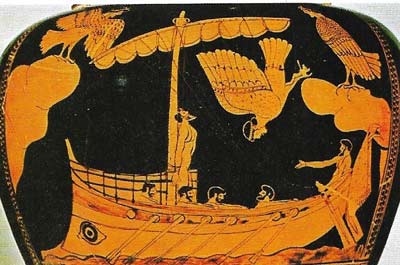
Figure 1. In the Odyssey Homer tells of the dangers and trials that beset the unfortunate Odysseus on his way home to Ithaca after fighting with the Greeks against Troy. Vase paintings show many incidents such as his encounter with the Sirens. He ordered his crew to stuff their ears with wax so that they would not be lured onto the rocks by the Sirens' song; but Odysseus was tied to the mast so that he could safely listen to them.
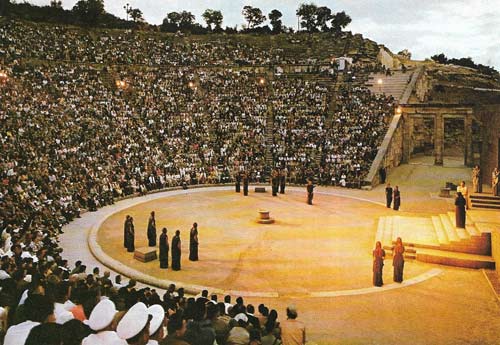
Figure 2. Seasons of Greek tragedy are presented annually at the magnificent theatre of Epidaurus, dating from the 4th century BC. The various parts of the theatre may be discerned. In front is the circular orchestra on which the chorus danced and sang. Behind it is the stage on which the actors stood. At the back of the stage is the skene, or permanent background, made of wood in early times and later of stone. The play shown is of Sophocles' Electra, the story of the revenge of Orestes, son of Agamemnon and brother of Electra, for his father's death. The actors are to the right, the chorus center and left. Of Sophocles' work, seven complete tragedies survive with several hundred fragments of others. Immensely successful in 5th-century Greece, he remains admired for the skill with which he structured his plays, but even more for his characterization, especially that of his heroines.
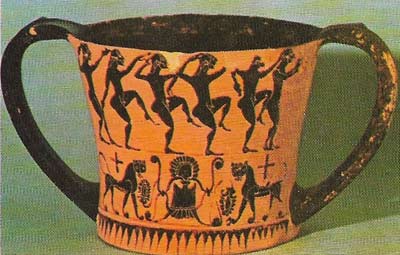
Figure 3. The chorus in a Greek tragedy is depicted on this vase as dancing to the meter of the verse and singing to the accompaniment of a flute. Particularly in its early period, Greek tragedy incorporated two styles. Dialogue between the actors, or the actors and chorus, was spoken in iambic rhythms. Choral odes, on the other hand, were based on many complex meters that reflected the emotions of the poetry.
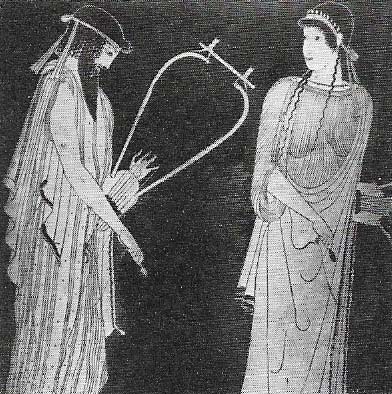
Figure 4. A wine cooler of the 5th century shows the lyric poets Alcaeus and Sappho. Little remains of Sappho's nine books of verse except for one ode, but there is enough to shoes her as unequalled for the passion and tenderness of her love poems. Alcaeus, her contemporary and friend, is also known only by fragments, which express political thoughts and outpourings of love and hate.
Only a fraction of the literature of ancient Greece has survived but what we have is superb in its diversity, nobility, and subtlety. Its influence on later European writers, both directly and through derived Latin literature, has been enormous.
The Iliad and the Odyssey
Homer, one of the greatest names in world literature, still remains a shadow. We do not know whether his works are a compilation of lays, the writings of two or more minstrels or the masterpieces of one towering genius, although the last seems unlikely. What is indisputable is that the Iliad and the Odyssey are among the greatest of literary works. Composed probably in the 8th century BC, they describe semi-legendary characters 500 years earlier.
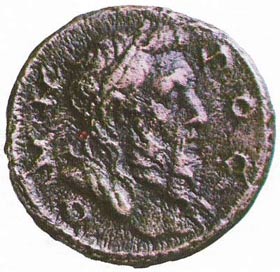 |
| Homer is regarded as the father of Greek literature. His importance can be judged by his appearance on this 4th-century coin from Ios. The Iliad and Odyssey probably evolved from singers' tales but scholars do not know how the poems reached their present form, or if one great figure created them |
The Iliad portrays events towards the end of the Trojan War. The story has a sub-stratum of fact, although basically it is a marvelous feat of poetic imagination. The shorter Odyssey (Figure 1) describes Odysseus' experiences on his return journey from the war. A little later than Homer, Hesiod wrote two epic poems with strong didactic elements, Works and Days and Theogony. The only other Greek epic poet of note was Apollonius (born c. 295 BC).
The Greek poets in general preferred the greater freedom of meter and expression offered by the lyric form. Lyric poetry developed from songs sung to the lyre and reached its height during the seventh and sixth centuries BC, but only fragments have survived to demonstrate the passion, charm, and vigor of the work of such poets as Terpander, Sappho, and Alcaeus (Figure 4) of Lesbos, Altman of Sparta, Anacreon of Ioni,a and Simonides of Ceos. Stesichorus, credited with the invention of the choral hymn celebrating the heroes of epic poetry, was a strong influence on Pindar (c. 522–c. 440 BC).
The Greek tragedians
Our debt to the Greeks is perhaps most marked in the field of drama. The 32 tragedies that have survived have moved audiences and inspired writers throughout the world for more than 2,000 years.
The three giants of Greek tragedy are Aeschylus (c. 525–456 BC), Sophocles (c. 496–c. 406 BC) and Euripides (c. 480–406 BC). Each has his own particular genius – Aeschylus his grandeur, Sophocles his ability to convey moral dilemmas and Euripides his insight into human nature. Greek tragedies were performed at festivals; three tragedies were given at a sitting plus one satyr play, a grotesque parody of ancient legends.
It is uncertain exactly how tragedy developed the sophisticated form that has come down to us. It seems likely that it grew out of choral songs performed at religious festivals. A semi-legendary poet named Thespis (hence "thespians", meaning actors) is reputed to have introduced a character who responded to the comments of the chorus. True drama involving conflict of character began when Aeschylus introduced a second actor. Sophocles used three actors and injected a greater degree of naturalism. Euripides offended many people by his cavalier treatment of the old subjects and the comparative realism of his themes. The motivation of his characters is convincing and his portraits of women memorable.
Greek comedy is virtually synonymous with the 11 plays we have by Aristophanes (c. 448–c. 388 BC). The comedy is broad, the characters ludicrous, but the satire of the life, ideas and leading figures of the time is often sharp. He is not afraid to lampoon even the gods. Menander (c. 342–292 BC) wrote urbane comedies of manners which lacked the exuberance and bite of Aristophanes. Imitated and translated into Latin by Plautus and Terence, they have influenced Shakespeare and Moliere.
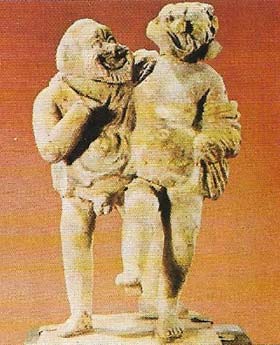 |
| This terracotta statuette of the 4th century shows two actors playing the roles of drunken old men. As was customary in Greek comedy, the actors wore grotesque masks and weird costumes, in this case padded jerkins and tights. Like tragedy, comedy had three actors and a chorus and the plays were performed at festivals. And like tragedy, comedy probably came from choral songs, but of a ribald nature. |
